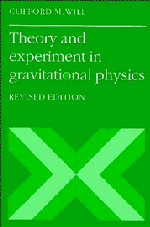Book contents
- Frontmatter
- Contents
- Preface to Revised Edition
- Preface to First Edition
- 1 Introduction
- 2 The Einstein Equivalence Principle and the Foundations of Gravitation Theory
- 3 Gravitation as a Geometric Phenomenon
- 4 The Parametrized Post-Newtonian Formalism
- 5 Post-Newtonian Limits of Alternative Metric Theories of Gravity
- 6 Equations of Motion in the PPN Formalism
- 7 The Classical Tests
- 8 Tests of the Strong Equivalence Principle
- 9 Other Tests of Post-Newtonian Gravity
- 10 Gravitational Radiation as a Tool for Testing Relativistic Gravity
- 11 Structure and Motion of Compact Objects in Alternative Theories of Gravity
- 12 The Binary Pulsar
- 13 Cosmological Tests
- 14 An Update
- References
- References to Chapter 14
- Index
7 - The Classical Tests
Published online by Cambridge University Press: 04 April 2011
- Frontmatter
- Contents
- Preface to Revised Edition
- Preface to First Edition
- 1 Introduction
- 2 The Einstein Equivalence Principle and the Foundations of Gravitation Theory
- 3 Gravitation as a Geometric Phenomenon
- 4 The Parametrized Post-Newtonian Formalism
- 5 Post-Newtonian Limits of Alternative Metric Theories of Gravity
- 6 Equations of Motion in the PPN Formalism
- 7 The Classical Tests
- 8 Tests of the Strong Equivalence Principle
- 9 Other Tests of Post-Newtonian Gravity
- 10 Gravitational Radiation as a Tool for Testing Relativistic Gravity
- 11 Structure and Motion of Compact Objects in Alternative Theories of Gravity
- 12 The Binary Pulsar
- 13 Cosmological Tests
- 14 An Update
- References
- References to Chapter 14
- Index
Summary
With the PPN formalism and its associated equations of motion in hand, we are now ready to confront the gravitation theories discussed in Chapter 5 with the results of solar system experiments. In this chapter, we focus on the three “classical” tests of relativistic gravity, consisting of (i) the deflection of light, (ii) the time delay of light, and (iii) the perihelion shift of Mercury.
This usage of the term “classical” tests is a break with tradition. Traditionally, the term “classical tests” has referred to the gravitational redshift experiment, the deflection of light, and the perihelion shift of Mercury. The reason is largely historical. These were among the first observable effects of general relativity to be computed by Einstein. However, in Chapter 2 we saw that the gravitational red-shift experiment is really not a test of general relativity, rather it is a test of the Einstein Equivalence Principle, upon which general relativity and every other metric theory of gravity are founded. Put differently, every metric theory of gravity automatically predicts the same red-shift. For this reason, we have dropped the red-shift experiment as a “classical” test (that is not to deny its importance, of course, as our discussion in Chapter 2 points out). However, we can immediately replace it with an experiment that is as important as the other two, the time delay of light.
- Type
- Chapter
- Information
- Theory and Experiment in Gravitational Physics , pp. 166 - 183Publisher: Cambridge University PressPrint publication year: 1993

